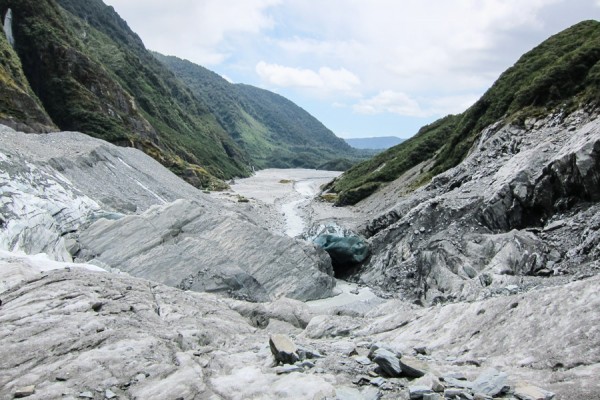

Franz Josef is situated about 5 hours drive from Christchurch and the nearest notable town is Hokitika – about an hour and a half drive away. Franz Josef village is in a high rainfall zone with mild temperatures. This provides a very rare opportunity to experience a dynamic glacier in a temperate environment, within easy driving and walking distance from the main highway. Maybe even more reason to go and see this region for yourself now.Franz Josef Glacier tumbles down from the tops of the white, lofty Southern Alps (the tallest in New Zealand) into the rainforest covered valley close to sea level at the astonishing rate of about 70cm per day – about 10 times faster than normal glaciers. If that is the case – and there’s a strong likelihood it will be – that’s really sad.

Maybe this will be the kind of place we can only tell future generations about, showing them photos and explaining how the natural world looked before the temperature rose too much. Or there are some tours that take you much closer to the glaciers themselves on foot. Helicopter rides are expensive so, if that’s not within your budget, you can walk up both valleys and see the face for free. It is still worth the visit these days, even if you can no longer walk up on the ice. You have a physical one in front of you.Īll you need to do is visit Fox Glacier or Franz Josef Glacier again within a year or two and you’ll see the difference.

Well, here in this part of New Zealand, you don’t need a mental image. We know it will change our planet, sea levels will rise, agriculture will be affected, species may be wiped out, and there will be an imbalance in nature that could have many more unpredictable effects.īut it is all happening so slowly and sometimes it is hard to picture, to get a mental image of what climate change. Most of us believe that it is caused (or at least amplified) by human behaviour. We hear a lot about climate change in the news. And it is probably important that we do think about this kind of thing. It gives you time to think about it, if you let yourself. It helps that the route has so much to look at but it’s a stark reminder that since 2008 this glacier has been in a period of retreat and has lost around 800 metres of length. It can take almost an hour if you take your time and enjoy the surroundings. The walk from the carpark to the face of the Franz Josef Glacier is beautiful – but quite long. The smallest glaciers have lost about 12 metres of thickness in that time. Since 1977, the Southern Alps of New Zealand have lost 34 per cent of their ice and snow cover. They’re convinced that human-caused climate change is the major cause. Some of it is natural and these ice formations always grow and shrink a bit over time depending on the weather conditions of each year.īut the acceleration of the decline in size is increasing and scientists don’t think it has ever been as fast as it has been in recently.
#Franz josef glacier new zealand full
While the Fox Glacier valley has mainly grey rocks and a rounder shape, the Franz Josef Glacier valley is full of orange rocks, has more plants, and is steeper on the sides.įranz Josef Glacier is also receding – all of the glaciers here in New Zealand are.

Only a 30 minute drive from Fox Glacier is Franz Josef Glacier and it really is worth seeing them both.īoth are rivers of ice, fair enough, but the valleys you walk along to reach the glaciers are different and have their own unique characteristics. Helicopter tours are now the best way to get a good view.įor visitors to this glacier region of New Zealand, on the west coast of the South Island, there are a few must-sees. Until the past couple of years, you could do a walking tour onto the ice but that’s now been stopped because it’s too dangerous. It’s one of the few ways to see the glacier. It is quite a walk these day and takes more than 30 minutes to the point where you get a good view of the glacier’s face. But recently it’s been accelerating – and it’s got scientists worried.Įven just in the past few years, it’s noticeable how far the face of the glacier has moved.Īfter driving from the main road, you reach a car park where you leave your vehicle and walk the rest of the way. Some is the natural progression of a flowing river of ice. It has moved a long way in this time – about three kilometres since the 1880s. It is the sad not-so-cold reality of climate change.Īs you drive along the final road towards Fox Glacier, signs on the side mark the point where the face of the ice was at various points in history. It’s not what we should be aspiring towards. The sad new motto of New Zealand’s glaciers. Fox Glacier and Franz Josef Glacier, South Island, New Zealand


 0 kommentar(er)
0 kommentar(er)
